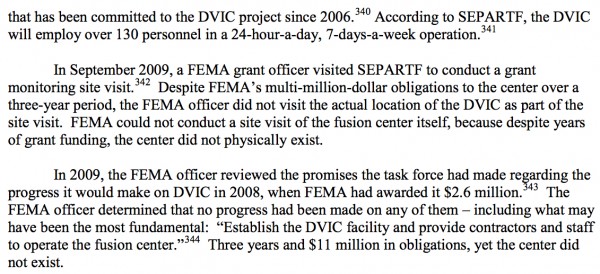Artwork by SHEPHERD FAIREY
WASHINGTON POST: An initiative aimed at improving intelligence sharing has done little to make the country more secure, despite as much as $1.4 billion in federal spending, according to a two-year examination by Senate investigators. The nationwide network of offices known as “fusion centers” was launched after the Sept. 11, 2001, attacks to address concerns that local, state and federal authorities were not sharing information effectively about potential terrorist threats. But after nine years — and regular praise from officials at the Department of Homeland Security — the 77 fusion centers have become pools of ineptitude, waste and civil liberties intrusions, according to a scathing 141-page report by the Senate Homeland Security and Governmental Affairs permanent subcommittee on investigations. The creation and operation of the fusion centers were promoted by the administration of President George W. Bush and later the Obama administration as essential weapons in the fight to build a nationwide network that would keep the country safe from terrorism. The idea was to promote increased collaboration and cooperation among all levels of law enforcement across the country. But the report documents spending on items that did little to help share intelligence, including gadgets such as “shirt button” cameras, $6,000 laptops and big-screen televisions. One fusion center spent $45,000 on a decked-out SUV that a city official used for commuting. MORE
NEW YORK TIMES: One of the nation’s biggest domestic counterterrorism programs has failed to provide virtually any useful intelligence, according to Congressional investigators. Their scathing report, to be released Wednesday, looked at problems in regional intelligence-gathering offices known as “fusion centers” that are financed by the Department of Homeland Security and created jointly with state and local law enforcement agencies. The report found that the centers “forwarded intelligence of uneven quality — oftentimes shoddy, rarely timely, sometimes endangering citizens’ civil liberties and Privacy Act protections, occasionally taken from already published public sources, and more often than not unrelated to terrorism.” The investigators reviewed 610 reports produced by the centers over 13 months in 2009 and 2010. Of these, the report said, 188 were never published for use within the Homeland Security Department or other intelligence agencies. Hundreds of draft reports sat for months, awaiting review by homeland security officials, making much of their information obsolete. And some of the reports appeared to be based on previously published information or facts that had on long since been reported through the Federal Bureau of Investigation. The Congressional investigators also found that the reports were often derided by homeland security analysts who reviewed the work. “I see nothing to be gained by releasing this report,” one analyst wrote repeatedly on several draft reports. “This report does not provide the who, what, when, where, how,” another official complained about a document. The investigators also discovered that federal officials cannot account for as much as $1.4 billion in taxpayer money earmarked for fusion centers and that some of the centers listed on paper by the Homeland Security Department do not even exist. The report also lays out problems in protecting citizens’ privacy as the centers gathered and disseminated intelligence. The Department of Homeland Security provided only one week of training to officials assigned to sift through tips and uncorroborated information about American citizens that came into their offices. MORE
PHAWKER: And then here’s our piece of the boondoggle — an $11 billion hole in the Federal Treasury and nothing to show for it. From page 62:



